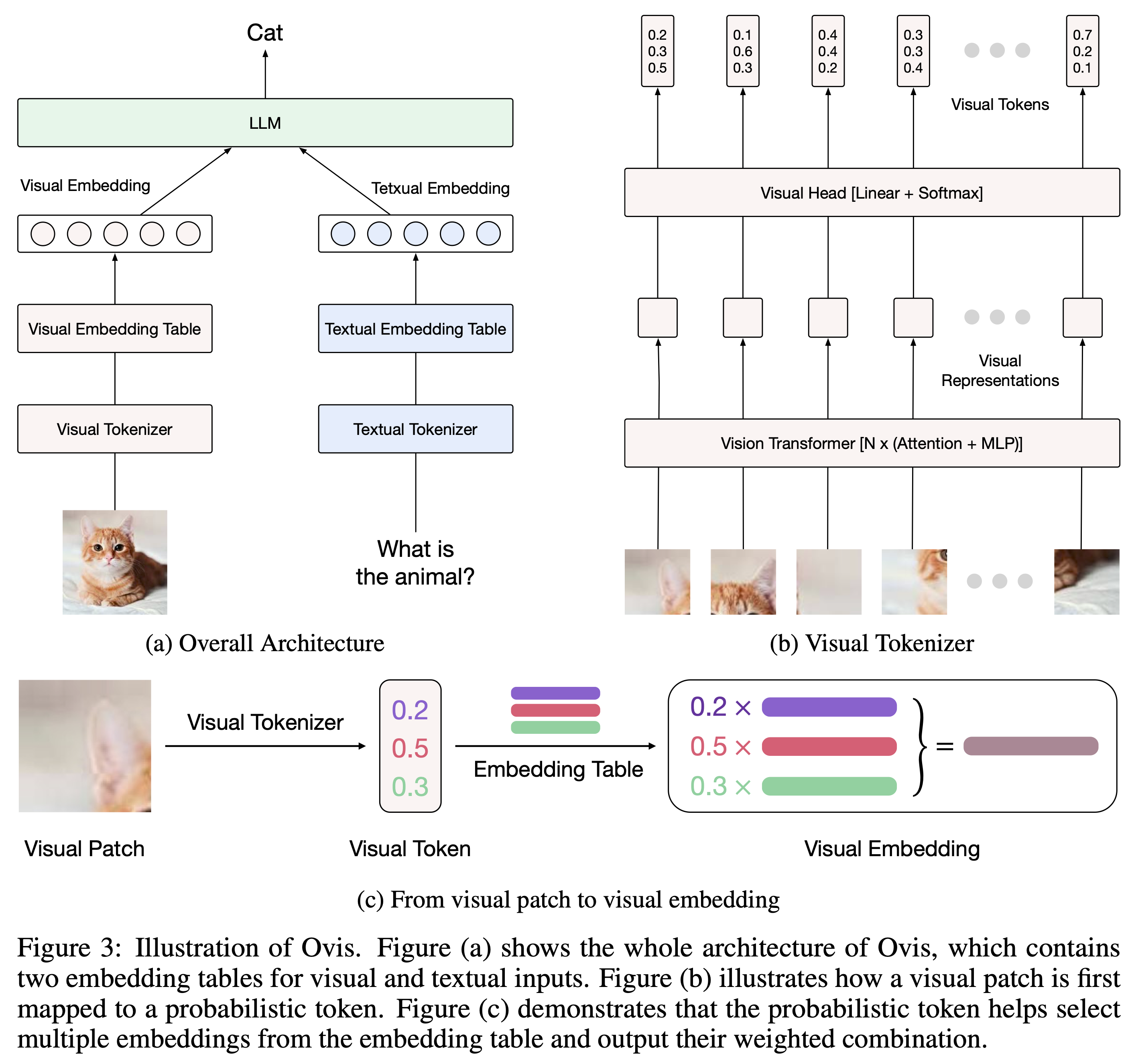---
license: apache-2.0
datasets:
- AIDC-AI/Ovis-dataset
library_name: transformers
tags:
- MLLM
pipeline_tag: image-text-to-text
language:
- en
---
# Ovis1.6-Gemma2-9B-GPTQ-Int4

## Introduction
[GitHub](https://github.com/AIDC-AI/Ovis) | [Demo](https://huggingface.co/spaces/AIDC-AI/Ovis1.6-Gemma2-9B) | [Paper](https://arxiv.org/abs/2405.20797)
We are excited to announce the open-sourcing of **Ovis-1.6**, our latest multi-modal large language model. Ovis is a novel Multimodal Large Language Model (MLLM) architecture, designed to structurally align visual and textual embeddings.

## Model
Built upon Ovis1.5, **Ovis1.6** further enhances high-resolution image processing, is trained on a larger, more diverse, and higher-quality dataset, and refines the training process with DPO training following instruction-tuning.
| Ovis MLLMs | ViT | LLM | Model Weights | Demo |
|:------------------|:-----------:|:------------------:|:---------------------------------------------------------------:|:----------------------------------------------------------------:|
| Ovis1.6-Gemma2-9B | Siglip-400M | Gemma2-9B-It | [Huggingface](https://huggingface.co/AIDC-AI/Ovis1.6-Gemma2-9B) | [Space](https://huggingface.co/spaces/AIDC-AI/Ovis1.6-Gemma2-9B) |
## Quantized Model: GPTQ-Int4
We quantized Ovis1.6 with AutoGPTQ. Follow these steps to run it.
### Installation
1. Run the following commands to get a basic environment. Be sure to run with CUDA 12.1.
```bash
conda create -n python=3.10
conda activate
pip install torch==2.2.1 torchvision==0.17.1 torchaudio==2.2.1 --index-url https://download.pytorch.org/whl/cu121
pip install numpy==1.24.3 transformers==4.44.2 pillow==10.3.0 gekko pandas
```
2. Build AutoGPTQ: We customized AutoGPTQ to support Ovis model quantization. You need to build from source to install the customized version.
```bash
git clone https://github.com/kq-chen/AutoGPTQ.git
cd AutoGPTQ
pip install -vvv --no-build-isolation -e .
```
Check [this](https://github.com/AutoGPTQ/AutoGPTQ/issues/194) first if you are building inside a Docker container.
### Usage
Below is a code snippet to run Ovis1.6-Gemma2-9B-GPTQ-Int4 with multimodal inputs. For additional usage instructions, including inference wrapper and Gradio UI, please refer to [Ovis GitHub](https://github.com/AIDC-AI/Ovis?tab=readme-ov-file#inference).
```python
import torch
from PIL import Image
from transformers import GenerationConfig
from auto_gptq.modeling import OvisGPTQForCausalLM
# load model
load_device = "cuda:0" # customize load device
model = OvisGPTQForCausalLM.from_pretrained(
"TryingHard/Ovis1.6-Gemma2-9B-GPTQ-Int4",
device=load_device,
multimodal_max_length=8192,
trust_remote_code=True
)
model.model.generation_config = GenerationConfig.from_pretrained("TryingHard/Ovis1.6-Gemma2-9B-GPTQ-Int4")
text_tokenizer = model.get_text_tokenizer()
visual_tokenizer = model.get_visual_tokenizer()
# enter image path and prompt
image_path = input("Enter image path: ")
image = Image.open(image_path)
text = input("Enter prompt: ")
query = f'\n{text}'
# format conversation
prompt, input_ids, pixel_values = model.preprocess_inputs(query, [image])
attention_mask = torch.ne(input_ids, text_tokenizer.pad_token_id)
input_ids = input_ids.unsqueeze(0).to(device=model.device)
attention_mask = attention_mask.unsqueeze(0).to(device=model.device)
pixel_values = [pixel_values.to(dtype=visual_tokenizer.dtype, device=visual_tokenizer.device)]
# generate output
with torch.inference_mode():
gen_kwargs = dict(
max_new_tokens=1024,
do_sample=False,
top_p=None,
top_k=None,
temperature=None,
repetition_penalty=None,
eos_token_id=model.generation_config.eos_token_id,
pad_token_id=text_tokenizer.pad_token_id,
use_cache=True
)
output_ids = model.generate(input_ids, pixel_values=pixel_values, attention_mask=attention_mask, **gen_kwargs)[0]
output = text_tokenizer.decode(output_ids, skip_special_tokens=True)
print(f'Output:\n{output}')
```
Batch inference
```python
batch_inputs = [
('example_image1.jpeg', 'Describe the content of this image.'),
('example_image2.jpeg', 'What is the equation in the image?')
]
batch_input_ids = []
batch_attention_mask = []
batch_pixel_values = []
for image_path, text in batch_inputs:
image = Image.open(image_path)
query = f'\n{text}'
prompt, input_ids, pixel_values = model.preprocess_inputs(query, [image])
attention_mask = torch.ne(input_ids, text_tokenizer.pad_token_id)
input_ids = input_ids.unsqueeze(0).to(device=model.device)
attention_mask = attention_mask.unsqueeze(0).to(device=model.device)
pixel_values = [pixel_values.to(dtype=visual_tokenizer.dtype, device=visual_tokenizer.device)]
batch_input_ids.append(input_ids.squeeze())
batch_attention_mask.append(attention_mask.squeeze())
batch_pixel_values.append(pixel_values)
pad_batch_input_ids = torch.nn.utils.rnn.pad_sequence([i.flip(dims=[0]) for i in batch_input_ids],batch_first=True, padding_value=0.0).flip(dims=[1])
pad_batch_input_ids = pad_batch_input_ids[:,-model.config.multimodal_max_length:]
pad_batch_attention_mask = torch.nn.utils.rnn.pad_sequence([i.flip(dims=[0]) for i in batch_attention_mask],batch_first=True, padding_value=False).flip(dims=[1])
pad_batch_attention_mask = pad_batch_attention_mask[:,-model.config.multimodal_max_length:]
pad_batch_pixel_values = [item for sublist in batch_pixel_values for item in sublist]
# generate output
with torch.inference_mode():
gen_kwargs = dict(
max_new_tokens=1024,
do_sample=False,
top_p=None,
top_k=None,
temperature=None,
repetition_penalty=None,
eos_token_id=model.generation_config.eos_token_id,
pad_token_id=text_tokenizer.pad_token_id,
use_cache=True
)
output_ids = model.generate(pad_batch_input_ids, pixel_values=pad_batch_pixel_values, attention_mask=pad_batch_attention_mask, **gen_kwargs)
for i in range(len(batch_input_ids)):
output = text_tokenizer.decode(output_ids[i], skip_special_tokens=True)
print(f'Output_{i}:\n{output}')
```
## Performance
Here we report the performance of Ovis1.6-Gemma2-9B-GPTQ-Int4. The results are obtained with VLMEvalkit.

## Citation
If you find Ovis useful, please cite the paper
```
@article{lu2024ovis,
title={Ovis: Structural Embedding Alignment for Multimodal Large Language Model},
author={Shiyin Lu and Yang Li and Qing-Guo Chen and Zhao Xu and Weihua Luo and Kaifu Zhang and Han-Jia Ye},
year={2024},
journal={arXiv:2405.20797}
}
```
## License
This project is licensed under the [Apache License, Version 2.0](https://www.apache.org/licenses/LICENSE-2.0.txt) (SPDX-License-Identifier: Apache-2.0).
## Disclaimer
We used compliance-checking algorithms during the training process, to ensure the compliance of the trained model to the best of our ability. Due to the complexity of the data and the diversity of language model usage scenarios, we cannot guarantee that the model is completely free of copyright issues or improper content. If you believe anything infringes on your rights or generates improper content, please contact us, and we will promptly address the matter.

